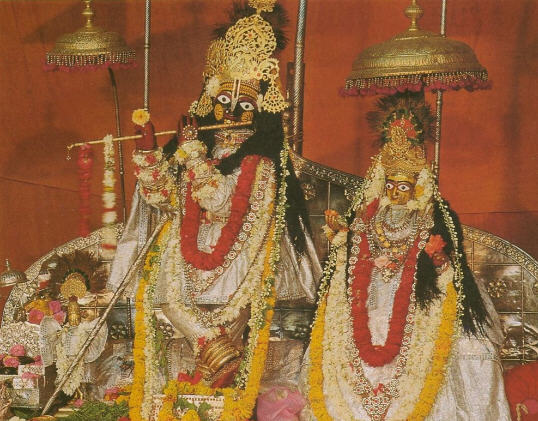
Sri Radha Govindaji
In Jaipur, the capital of "the Land of Kings," Lord Krsna is the center of devotion.
WHILE VISITING JAIPUR, the capital of the Indian state of Rajasthan ("the Land of Kings"), I have the good fortune to stay two houses away from the city's most famous Krsna temple, the Govindaji Temple. I can easily walk to mangala-arati, the early-morning worship, without having to look for a ricksha. At 4:55 A.M. I walk out my host's front gate and join the hundreds of rickshas, scooters, bicycles, and pedestrians hurrying toward the temple. The street buzzes with spiritual energy.
I walk across the temple compound and leave my shoes under a tree, praying to find them again among the thousands of shoes scattered all around. The large pink latticed wooden doors to the Deity room are still locked and chained, but a large crowd has already gathered, and people are singing again and again, "Govinda Hari, Gopala Hari, Jaya Jaya Prabhu Dina-dayala Hari."
As the doors open, a white curtain is drawn sideways, unveiling another white curtain. Worshipers throw coins and flower petals toward the Deity chamber. Then the second curtain opens to disclose the beloved forms of Sri Sri Radha-Govinda. A shower of coins and petals falls at Their feet, amid shouts of "Jaya ho! Govinda! Radhe-Govinda!"
The men gather to the left, the women to the right, and while the pujari (priest) offers arati (a ceremony of worship), the people sing. All at once, devotees ring brass gongs, at the back of the hall a group plays hand cymbals and clay drums, and small groups carry on with separate kirtanas a joyous cacophony in praise of Lord Govinda.
As the pujaris prepare to sprinkle sacred water over the heads of the worshipers, the crowd edges forward. No need to push the mighty waves of the crowd's ecstatic love for Govindaji carry one forward, closer and closer to the railing separating the hall from the raised platform around the Deity chamber. Some devotees dip under the rail and, arms outstretched, press their foreheads against the marble platform strewn with ghee-soaked grains. Their torsos forward, lower body in the kirtana hall, they are pressed still further forward by eager seekers of Govindaji's mercy. Yet soon they pull themselves back from under the rail and rejoin the crowd.
For about half an hour, Lord Govinda's devotees happily walk a circle around the Deity chamber, singing "Radhe-Govinda, Jaya Radhe Govinda, Radhe-Govinda, Jaya Radhe-Govinda, Jaya Radhe-Krsna, Pyare Krsna, Radhe-Govinda …" And while encircling the Deity, or on their way out, people share Deity prasadam. Women sit together in small groups to sing or speak about Govindaji and His wonderful pastimes.
Looking at the great multicolored river of devotees, crosscurrents flowing in and out of the Govindaji Temple, I remember Srila Rupa Gosvami's "warning": "My dear friend, if you are indeed attached to your worldly friends, do not look at the smiling face of Lord Govinda as He stands at Kesi-ghata on the bank of the Yamuna. Casting sidelong glances, He places His flute to His lips, which seem like newly blossomed twigs. His transcendental body, bending in three places, appears very bright in the moonlight."
Yes, Govindaji has ruined the worldly life of many of the people of Jaipur. All they seem to care for is to see Him and get His mercy.
Visakha-priya Devi Dasi, originally from France, joined ISKCON in 1978 in South Africa, where she served until 1991. She now lives at ISKCON's Krsna-Balarama Temple in Vrndavana, India, and is one of the managers of the Vrndavana Institute for Higher Education (VIHE).
Jaipur: City of Victory
IN 1727 THE RAJPUT KING Jai Singh II laid the foundation for a new capital city on a recently annexed territory. Jai Singh dedicated the city to Lord Govindaji and named it Jaipur, "city of victory."
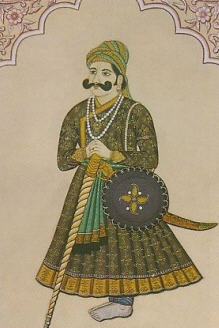
Jai Singh had Jaipur designed according to silpa sastra, the part of the Vedas that deals with design, architecture, and construction. The city was so well planned that even today town planners from all over the world come to study its layout.
The original city was protected by seven fortified gateways (pols), all still standing, and a masonry wall twenty feet high and nine feet thick. The city has now spread far beyond the wall, much of which has been torn down for building material.
The buildings of old Jaipur are built from solid blocks of reddish-pink sandstone. Sandstone readily cleaves into slabs, so buildings not built of it are faced with it. Jaipur was painted pink for a visit by Prince Albert in 1853 and became known as the Pink City. Staying true to the name, Jaipur still keeps the buildings diligently pink.
The major streets of the city are 111 feet wide. They cut the straight, narrow side lanes at right angles. The main street, two and a half miles long, runs from the Chand Pol to the Suraj Pol. On this street lies the entrance to the City Palace.
Within the precincts of the City Palace, which covers one seventh of the original city, Jai Singh built the Jantar Mantar, then India's greatest astronomical observatory. Its sundial gives the time down to two-second accuracy.
Jai Singh's great attachment to Lord Govinda led him to place Govindaji's temple across from his palace and link the two with fountains bordered with four rectangles of gardens. The gardens, where peacocks still strut about, are neatly surrounded by stone balustrades. From his bedroom Jai Singh could see Govindaji on the altar.
The flat-roofed temple includes a hall in front of the Deities, a wide area for walking around them, and a large Deity chamber topped with marble-embossed domes with brass spires. The walls and ceilings of the temple are decorated with intricate white stucco designs on a pink background.
North of the temple are extensive pools and gardens dotted with chatras, or gazebos. The rectangular gardens line the sides of two intersecting rows of fountains and pools. A watchtower stands above each of the four entrances to the temple compound.
Other Temples To Visit
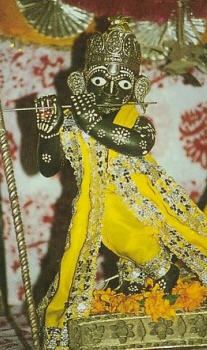
MANY DEITIES of Lord Krsna left Vrndavana during the Mogul invasions, and several of them ended up in Jaipur. A few are within walking distance of the Govindaji Temple. (Radha-Gopinatha)
Madhu Pandita Gosvami worshiped these Deities in Vrndavana. The temple is located in the Topkhanadesh area of Jaipur, near Chandpol Bazaar. Ask for directions when you're in the area.(Radha-Damodara)
These are the original Deities worshiped by Srila Jiva Gosvami in Vrndavana. The temple is on the right side of Chaura Rasta Road, about two hundred feet south of Tripolia Bazaar Road.(Vinodilal)
In this temple devotees worship the Deities of Radha-Vinoda originally worshiped by Srila Lokanatha Gosvami at the Radha-Gokulananda Temple in Vrndavana.
The Vinodilal Temple is on Tri-poliya Bazaar Road, about 150 feet west of Chaura Rasta Road. To the left of shop 295, a flight of stairs goes up to the temple.(Radha-Madhava)
Srila Jayadeva Gosvami worshiped these Deities. The temple is about five kilometers from downtown on Amber Road, on the right, next to a temple called Kanak Vrindavana. Look for the sign "Kanak Vrindavana and Govinda Deoji, Birla Restored."
Visiting Jaipur
How to Get There
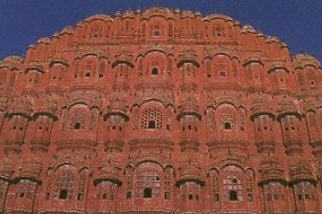
Plane: Direct flights from Delhi, Bombay, Calcutta, Udaipur, Varanasi, Aurangabad, and Ahmedabad.
Bus: From Delhi, 5 hours. From Vrndavana, 6 ½ hours. Deluxe buses are available from the interstate bus terminal in Delhi. Private companies also offer deluxe buses to Jaipur.
Train: From Delhi, about six hours, depending on the train. Trains also run from Agra, Udaipur, Hyderabad, and Mathura. Reservations are required.
Car: Taxis are available for round trips from Delhi or Vrndavana.
Where to Stay
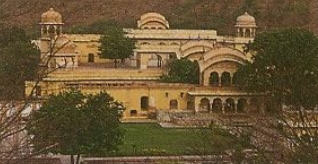
Jaipur has many hotels. We list here some recommended in the travel guidebook Holy Places and Temples of India, by Jada Bharata Dasa (available from our Hare Krsna Catalog).
Lower priced: Ever Green Guest House (phone: 363-4460), Jaipur Inn (316-157), Diggi Palace (373-091), Swagatam Tourist Bungalow (310-595).
Middle: Aangam Travellers Home (370-880), Atithi Guest House (378-679), Madhuban (319-033), Hotel Mangal (75126), Hotel Megh Niwas (32266).
High: LMB (565-844), Hotel Khasa Kothi (375-151), Narain Niwas Palace Hotel (310-3710).
Where to Eat
Strictly vegetarian restaurants: LMB (Johari Bazaar), Natraj and Surya Mahal (MI Road), Annapurna (behind Raj Mandir Cinema), Woodlands (Sawai Ram Singh Road), Canakya (MI Road).
ISKCON Jaipur
ISKCON has a center in Jaipur, of modest size, about twenty minutes from the middle of town. The center has no rooms for overnight guests, but otherwise has the full range of ISKCON programs.
The address: E-243 Ram Path, Shyam Nagar, Jaipur 302 001; phone: (0141) 364022.
